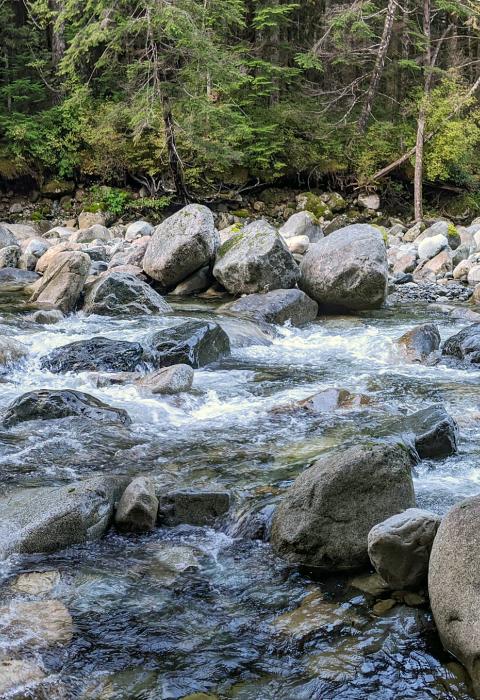Pratt River
Washington
The Pratt River is an exceptionally scenic waterway originating in the Alpine Lakes Wilderness within the Mt. Baker-Snoqualmie National Forest. The Pratt River is a tributary of the Middle Fork of the Snoqualmie River, which is estimated to supply up to 60% of the flow over Snoqualmie Falls and is considered an important source of cold water for salmon downstream in the watershed. The watershed supports wild runs of coho, chinook, pink, and chum salmon and steelhead, although the Pratt River is located above Snoqualmie Falls, a natural barrier to anadromous fish. A refurbished trail provides access to this beautiful mountain stream, especially for the nearby Seattle Metropolitan Area.
The Pratt River riparian corridor was intensely harvested in the last century, and the logging operations of the early upland habitats can still be seen today. The forest will not reach maturity for years and possibly centuries. However, despite significant changes to the landscape, as late as the 1980s, the Pratt River watershed remained an important area for tribal members to hunt and exercise their treaty rights. While these lands remain important use areas for tribal members, opportunities to exercise treaty rights, including hunting, have been diminished over time.
Riparian systems such as those in the Pratt River corridor will have an even more important role for wildlife under climate change scenarios. These riparian corridors connect habitats and ecological zones across elevational gradients, linking the aquatic portions of the wild and scenic rivers to the terrestrial habitat and upland areas.
Designated Reach
December 19, 2014. The entire 9.5-mile Pratt River, from its headwaters to its confluence with the Middle Fork of the Snoqualmie River.
Outstandingly Remarkable Values
Fish
Fish in this river have been cut-off from the downstream watershed since the last Ice Age due to the presence of Snoqualmie Falls, a barrier to anadromous fish, which has created genetic isolation. The presence of wild resident cutthroat trout and their genetic diversity are outstanding in the Pratt River, and the river is managed as a wild trout resource by Washington Department of Fish and Wildlife. DNA analysis of the coastal cutthroat trout showed subpopulations to be genetically distinct in the main stem and tributaries of the Middle Fork Snoqualmie River. The relatively high levels of genetic diversity are expected to allow greater adaptability to changing environmental conditions.
Wildlife
Wildlife is also an outstanding value of the Pratt River. The original 1990 river values assessment concluded that the riparian habitat and winter range in this area are extensive and of great importance for a variety of associated species, including elk, deer, mountain goat, black bear, beaver, and furbearers. More recent assessments identified the river-dependent harlequin duck as a species of concern. The river corridors provide critical refugia and essential cross-elevational riparian habitat to these species, given projected climate change impacts. The proximity of these river corridors to a large urban center provides both an exceptional opportunity for education and interpretation as well as a threat to the viability and integrity of riparian habitats and dependent species.

